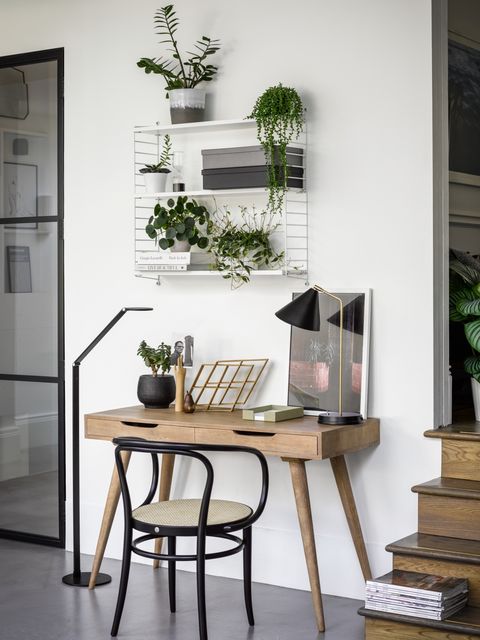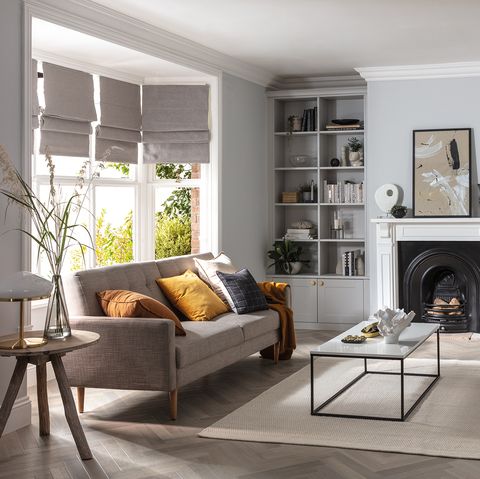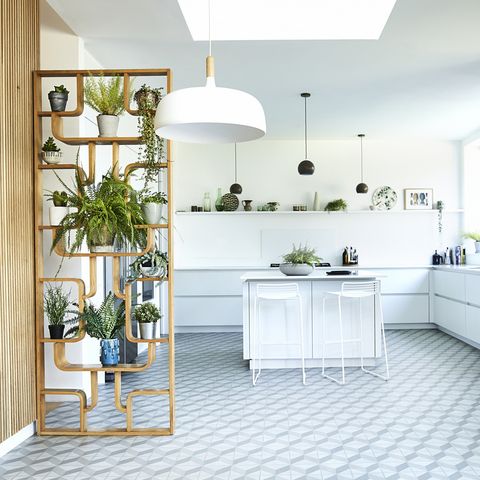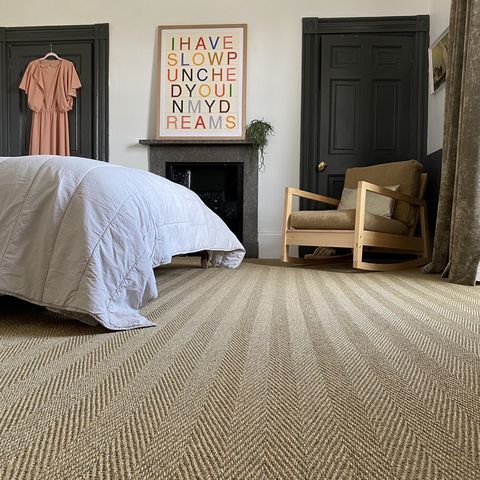Home is where the heart is, and we have 12 ways to turn yours into a haven of positive health and wellbeing for 2021.
Whether you live alone or share your living space with family or friends, home is an important part of our identity, says Eleanor Ratcliffe, environmental psychologist and lecturer at the University of Surrey: ‘Our homes have had to become workplace, school, and gym, and yet still be a place to relax and recover from all the everyday stresses and strains. A home design that reflects who you are – your values, needs, and interests – can make you feel good about yourself and more in control. This is especially relevant when life feels uncertain.’
1. Balance work and a relaxing space
The ideal work-from-home scenario is to find enough space to create your own home office, so you can close the door when the working day is over. If this isn’t possible, you may need help to switch off. ‘Use furniture or large plants to create broken-plan zones which allow you to separate work, relaxation and other activities such as cooking and eating,’ says interiors and home-staging expert. Elaine Penhaul at Lemon and Lime Interiors. ‘Zoning an open-plan room helps you utilise big spaces. You could use a large sofa or a tall, open bookcase as a divider.’
You can also deploy lighting to organise open-plan areas; create ‘rooms’ on different circuits so you can achieve the correct balance of task, ambient and accent lighting when natural daylight fades.
2. Make the most of natural light
Health-boosting natural light – which helps the body produce Vitamin D and fight off seasonal blues – is in short supply during the dark days of winter, so ‘harvest it and use it anywhere you can’, advise lighting experts Kate Wilkins and Sam Neuman, founders of Home Lighting Ideas.
‘If you need to spend long periods in a space that doesn’t get a lot of light, you may wish to think about installing an additional window,’ says David Knight, digital manager at Roof Windows 4 You. ‘A roof window can be easily added to a variety of different spaces, from a bathroom to a loft conversion, to provide both light and ventilation.’
A sun tunnel is a good alternative for rooms without roof access. It uses a mirror system to direct sunlight inwards to a location of your choice, from £252 at Roof Windows 4 You.
3. Don’t blow hot and cold
Being comfortable in a room that’s at the perfect temperature helps us to both focus and relax. However, this balance can be difficult to achieve if you share your living space with others. One solution is to investigate smart home heating systems, which can set different temperatures in individual rooms of the home. For instance, the Drayton Wiser thermostat, £219.99 for a Multi-zone Kit 1 (room thermostat, heat hub, app and two radiator thermostats), allows you to create up to 16 separate ‘zones’ each with their own individual temperature.
Also consider the flow of air through your rooms and air quality; if you choose a fan, air-conditioning unit or air purifier, make sure it comes with the Quiet Mark award – find a list of recommended products here, quietmark.com.
4. Cut down on chemicals
A natural home is a nurturing home. Make a vow to reduce the use of chemical-heavy detergent and cleaning materials and opt for natural alternatives kinder to your skin and general health. There’s a really good choice on the market now, including eco and vegan-friendly Ecozone cleaning sprays – including a Multi-Surface Cleaner, Limescale Remover and Daily Shower Cleaner – use natural plant extracts to lift away dirt and grime, from £3.49 at Ocado.
Always choose candles and wax melts made from soy wax rather than paraffin-based alternatives. The soy-based and vegan-friendly Self-Embrace candle by Kutch – a Cheshire company launched in June 2020 creating candles to promote positivity and wellbeing – has lavender oil for calm and rosemary and eucalyptus to clear your mind.
5. Keep it neat
The ancient Chinese art of Feng Shui is enjoying a resurgence. It’s all about maximising the positive energy that flows through your living space, and you can start by tidying up, says Rebecca Snowden, interior style advisor at furniture retailers Furniture And Choice: ‘A neat home works wonders for our mental clarity and overall health. In Feng Shui, each space is connected to each other and allows positive energy to flow throughout the house. Closets or drawers overloaded with old items block the chi (energy) so discard any clutter.’
Try the 10-minute bin-bag challenge every morning. Set a timer, take a bin bag and go around your home, collecting items no longer required and dispose of them thoughtfully, suggests Gary Lyons, managing director at Plastic Box Shop. ‘After a week, you’ll find that you have much less clutter in your home, so you’ll have a calmer, tidier mind, too.’
6. Reimagine your space
As part of their recent Happiness through Design campaign, The Royal Institute of British Architects (RIBA), found that most of us (70 per cent) believe that the design of our homes has affected our mental wellbeing during the pandemic.
Almost a quarter (23 per cent) of respondents said that a better-designed home would increase their happiness; they’d be able to relax more (31 per cent) and sleep better (17 per cent). So take time to think about how the space in your home is configured and what improvements or alterations you could make – such as an extension or loft conversion – within your budget.
A good place to start is asking an architect for advice. Many now offer a free initial telephone consultation or increasingly, a package of tailored advice to help you visualise what could be done before you take the plunge and start knocking down walls.
‘We’re trained to be creative and practical problem solvers and will add value, not just financial, but also to your quality of life – ensuring that your most sacred space works for you and your loved ones,’ says Ben Channon, RIBA chartered architect, head of wellbeing at Assael Architecture and author of the book, Happy by Design: A Guide to Architecture and Mental Wellbeing. ‘We will help you to make your home more usable and, put simply, a nicer place to live – ultimately making you happier and healthier.’ Find a RIBA-registered architect at architecture.com.
7. Pick perfect indoor plants
Houseplants look beautiful and can improve your health and wellbeing too. ‘For centuries, the Chinese have used houseplants to create “living energy” in their homes and workplaces,’ says Mike Burks, chairman of the Garden Centre Association (GCA). ‘Scientific studies have proven that houseplants are good for you – physically, emotionally and psychologically.’
Mike adds that plants can remove harmful chemicals from the air, such as those in paints and varnishes, new carpets and MDF, absorb noise and reduce dust, lower blood pressure, help concentration, improve memory, promote relaxation and make rooms look cared-for and welcoming.
The houseplants that Mike particularly recommends for boosting wellbeing include Spathiphyllum (Peace Lily), Nephrolepis (Boston Fern), Phlebodium Fern, Gerbera Daisy, Saint Paulia (African Violets), Ficus Benjamina (Weeping Fig), Sanserveria (Snake Plant), Chlorophytum (Spider Plant) and English Ivy.
If you really love plants, take it a step further. ‘If you’re looking to overhaul your home office for 2021, opt for a floral or palm leaf wallpaper to get that calming greenery hit on a larger scale,’ recommends Calum Henderson, interior design manager at I Love Wallpaper.
8. Find a place for everything
Take a look around your home and identify areas you can devote to health and wellbeing. ‘Along with work and rest, making space for self-care and enrichment goes a long way towards enhancing wellness in the home,’ says Rebecca Snowden. ‘Whether it’s a warm reading nook or a place for crafts and hobbies, it’s a crucial space to have, and likely to become a quick favourite.’
It’s important to personalise this space, says Nadia McCowan Hill, resident style advisor at online homes retailer Wayfair: ‘Creating characterful and personalised vignettes throughout the home is set to be a huge trend for 2021, especially when related to small spaces. Play around with the classic “shelfie” or curated coffee table display for an area that is truly your own – a fun, creative outlet and importantly a celebration of your style and identity in these uncertain times.’
For maximum relaxation, incorporate Feng Shui yin and yang into your décor. ‘Yin (feminine) and yang (masculine) is a belief that two contrasting forces cannot exist without each other,’ says Rebecca. ‘Apply this concept by mixing different shapes together. For example, contrast the sharp edges of wall hangings with the soft curves of a sofa or mirror in the living room. This will balance out the room and give it a more relaxing feel.’
9. Choose natural and sustainable materials
‘Our homes and gardens have become our everything and we’re increasingly looking to surround ourselves with natural, sustainable materials,’ says Clare Thomas, marketing manager at Cotswolds-based artisan homeware company Indigenous.
She adds that rustic wood and stone are hugely popular: ‘They connect us with nature and bring texture, along with a real sense of calm and wellbeing. There’s also growing interest in rustic “worn-away” patterned tiles in natural shades, like fawn, pale blue and sage. This new look is very subtle and some porcelain finishes, like our handmade Tuscan tile, can be used outside as well as indoors.’
Materials such as sisal for flooring and wicker for furniture and decorative items such as lampshades and pendants are also enjoying a renaissance. Sisal is naturally moth and dust-mite resistant. With neutral tones and a subtle texture, it’s ideal for creating a pleasing bridge between wooden and stone flooring. ‘It’s also a healthy solution for those who suffer from asthma, eczema and other allergies,’ says Julian Downes, director at natural flooring company fibre. ‘It is extremely hard-wearing and if looked after, will look beautiful for years.’
10. Opt for wintertime shades and textures
Colour has the power to transform a room and create different moods, so it’s crucial to choose the right shades to help you feel comfortable and relaxed at home. ‘Always keep in mind that, as a guide, warm colours such as red, orange and yellow are considered to be stimulating, while cool tones of blue and green tend to be more restful and soothing,’ says Judy Smith, Crown Paints’ colour consultant.
In wintertime, Judy takes inspiration from the colours of nature: ‘Trying to recreate the feeling of outdoors as an escape in our home starts with the colours and the materials we choose. A quieter, more organic colour story made of tones of green, clay and wood creates a lovely, calming, natural space that can help to boost our wellbeing.’
Natural textures also help us to connect with the outdoors. Sarah Jane Nielsen, founder of interior design firm Nielsen House, based in the Lake District, is keen on cork. ‘I love the natural warmth of cork and bark tiles, which are produced sustainably, biodegradable and eco-friendly,’ she says. ‘You can also buy cork on a roll with adhesive backing. It’s brilliant in a home workspace; you can pin up your notes, articles, photos and planners.’
Mixing fabric textures is vital to achieving a truly cosy feel, so layer tactile velvets, weaves, knits and cottons across soft furnishings to tie your look together, suggests Suzy McMahon, buying director at Sofology.
11. Soak away your cares
Creating a sanctuary in your bathroom is easy. Fit a shelf or add a side table beside the bath at just the right height for your favourite essential oils, add an electric towel rail for warm fluffy towels and a soft bath mat to sink your toes into.
And then of course, there’s the bath. ‘The freestanding bath has remained a staple design piece for the British bathroom for many years,’ says James Stevenson at Imperial Bathrooms. ‘As the market continues to focus on promoting greater health and wellbeing at home, this style of tub remains the go-to for the right balance of luxury, comfort and practicality,’
Baths made from natural materials such as copper or tin are good conductors of heat and will keep bathwater warmer for longer than synthetic materials.
12. Bring together inside and out
We’ve loved spending as much time as possible outside during the warmer months and now the weather is colder we don’t want to let that connection with nature go.
‘One way to maximise this is by incorporating bi-folding or sliding doors,’ says Victoria Brocklesby, founder and CEO at Origin. ‘The large expanse of glass will seamlessly link the inside of your home with the outside, offering a widescreen view of your garden and helping you feel connected to the great outdoors, come rain or shine.’
A living wall – also known as a vertical garden – is a beautiful and space-saving way to connect indoors and out, adds Sarah Jane Nielsen: ‘There are lots of options here: you can build a frame and enjoy the growing, feeding and garden maintenance yourself – many find it incredibly calming – or you can opt for ready-built self-sufficient living wall systems that water themselves.’ You could even plant herbs to snip off and add to warming stews and soups.
12 Days of Christmas Wellbeing: boost your mental wellbeing, take joy from the small things, and create a happy home this festive season.
Like this article?Sign up to our newsletter to get more articles like this delivered straight to your inbox.
In need of some positivity or not able to make it to the shops? Subscribe to House Beautiful magazine today and get each issue delivered directly to your door.
This content is created and maintained by a third party, and imported onto this page to help users provide their email addresses. You may be able to find more information about this and similar content at piano.io





















More Stories
How To Find A Custom Home Builder Without Losing Your Mind
5 Realistic Real Estate Considerations!
12 Critical Thoughts to Contemplate When Constructing a Dwelling Extension in Ireland